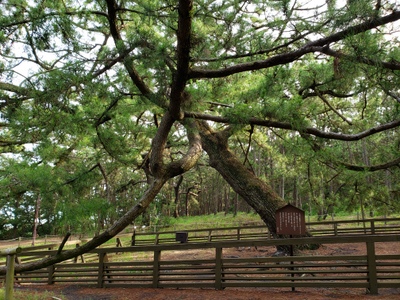Difference between revisions of "Hagoromo"
(Created page with "*''Japanese'': 羽衣 ''(Hagoromo)'' ''Hagoromo'' is a Noh play featuring a ''tennyo'' (often translated as Celestial Maiden) who leaves her feathered cloak (''hagoromo''...") |
|||
| Line 1: | Line 1: | ||
| + | [[File:Hagoromo-no-ki.jpg|right|thumb|400px|A pine tree at [[Miho no Matsubara]] labeled as being the one where the events of the play are said to have taken place]] | ||
*''Japanese'': 羽衣 ''(Hagoromo)'' | *''Japanese'': 羽衣 ''(Hagoromo)'' | ||
Latest revision as of 11:31, 13 July 2020

- Japanese: 羽衣 (Hagoromo)
Hagoromo is a Noh play featuring a tennyo (often translated as Celestial Maiden) who leaves her feathered cloak (hagoromo) hanging the branch of a pine tree at the shore at Miho no Matsubara (today, Shizuoka prefecture) while bathing in the sea. A fisherman finds her, takes the cloak, and returns it in exchange for witnessing her dance.
The Celestial Maiden is played by the shite actor, and the fisherman by the waki actor. The play is considered a genzai Noh, taking place in the current time of the setting, as opposed to involving spirits retelling or reenacting events of the past as in a mugen Noh play.
The earliest documentary mention of the play is in 1524. It may derive from significant borrowings from the repertoire of Ômi sarugaku, a significant predecessor to Noh.[1] The play was first adapted for the kabuki stage in 1898.[2]
References
- ↑ Shelley Fenno Quinn, Developing Zeami, University of Hawaii Press (2005), 49-54.
- ↑ "Onoe Kikugorô V," Kabuki21.com.